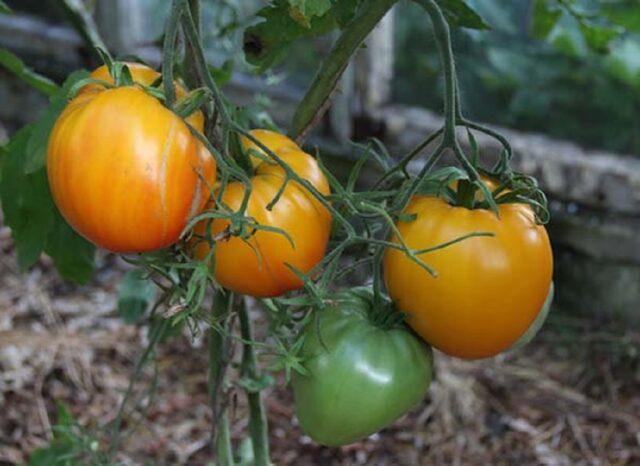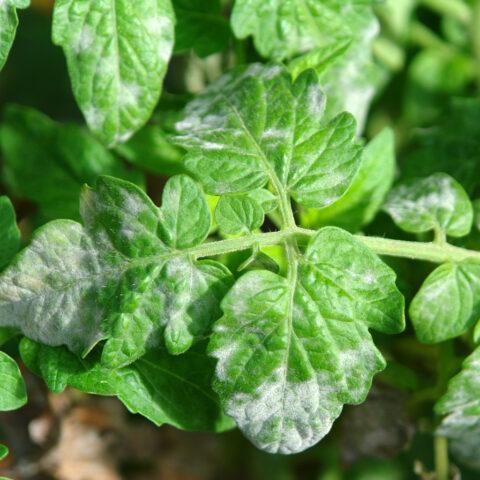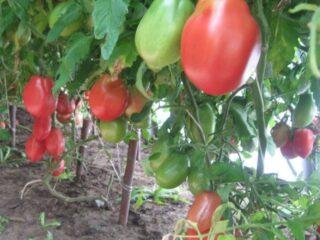Content
Tomato Golden Domes is a tall determinate variety of Siberian selection. The plant is cold-resistant, adapted to sudden changes in temperature at the beginning of the growing season. Tomatoes are large-fruited, have high nutritional value, and are hypoallergenic. Fruiting is stable both in the greenhouse and in the open area. Golden Dome tomatoes have held the leading position in popularity among yellow-fruited varieties for many years.
History of selection
The tomato was created on the basis of the Siberian Garden agricultural company; the originators were a group of scientific breeders led by V.N. Dederko. After experimental cultivation in a temperate continental climate, the Golden Domes variety was included in the State Register in 2005. The variety is part of the Sibiriada series. The variety is recommended for cultivation in open ground (OG) and greenhouse conditions in risky farming zones.
Description of the tomato variety Golden Domes

Tomato Golden Domes tall, determinate type, non-standard
The bush is formed with two stems: the main one and a strong side shoot of the first order. In the OG the plant height reaches 1 m, in the greenhouse 1.5 m. Golden Domes is a large-fruited varietal representative of the crop, adapted to the unstable weather of the Siberian and Ural regions.
The tomato is medium-late, the main ripening of the fruit occurs 110 days after germination. The tomatoes do not ripen at the same time. The first fruits are picked from the lower cluster in mid-August, the last ones - at the end of September. Fruits of technical ripeness ripen fully at home.
Golden Domes is a generative type variety. After the plant reaches the end point of growth, nutrition is directed to the formation of fruits, and not to the growth of green mass. The tomato has few stepsons and average foliage. The formation of the first fruit cluster occurs from the eighth leaf axil, the subsequent ones grow after 2-3.
Biological characteristics:
- Tomato is an open type, the stems are medium thick, woody, fibrous, finely pubescent, brown in color.
- The leaf blades are pointed, with a corrugated surface and finely toothed edges. The leaves are medium-sized, complex, alternate, drooping.
- The flowers are small, bright orange.
- Fruit clusters are simple, consist of 3-6 ovaries, in a greenhouse there are up to 6 pieces on a stem, in a greenhouse - 3-4 pieces.
- The root system is superficial, compact.
- The fruits are large from the first to the last cluster, of different weights; on the lower clusters they can reach 700 g, on the middle ones - 400 g, on the final cluster - 200 g.
- The shape of the tomatoes is heart-shaped, ribbed in the area of the stalk, the main color background is yellow with red-orange areas on the sides and on the top.
- The pulp is fine-grained, juicy, yellow with 4-6 chambers. The seeds are small, few in number, light beige in color.
- The peel is thin. With a lack of moisture and lack of nutrition, it is prone to cracking.
Golden domes - salad tomato. Tasting score – 4.7 points out of 5 possible. The taste is sweet, without the presence of acid, but not bland. The nightshade aroma is weakly expressed.
Recommended for growing in gardens and summer cottages. Transportability is poor, shelf life is no more than four days. Cultivation on an industrial scale is unprofitable.
Yellow fruits have a high concentration of carotene, sugars and lycopene
Characteristics of tomato Golden Domes
A feature of the varieties of Siberian selection is their high cold resistance. Tomato Golden Domes begins the growing season at a temperature of +4 0C. If the indicator is lower, growth stops, but the plant does not die. In case of frost damage, it forms a replacement and quickly gains green mass. Weather conditions do not affect flowering times.
Tomato yield Golden domes
There are few fruits on the bush. A good indicator is achieved due to mass. One plant, formed by two stems, produces up to 4.5 kg. At 1 m2 Three tomatoes are planted.
Subject to the conditions of agricultural technology from 1 m2 take 12-14 kg.
Resistance to diseases and pests
During the experimental cultivation, tomato immunity was repeatedly adjusted.Varietal representatives are less resistant to pests and diseases, but they benefit from taste.
The problems that vegetable growers face during the growing process are the infection of the plant by a number of pathogens that cause: leaf mold, fusarium wilt, and late blight.
The Golden Domes variety has good resistance to tobacco mosaic, cladosporiosis and fomosis.
Of the insects in OG, the whitefly parasitizes the tomato, and the spider mite in greenhouses. If there is no nightshade planting nearby, the Colorado potato beetle is not harmful to tomatoes.
How to use
The Golden Domes variety is not suitable for long-term storage. Tomatoes can be consumed fresh or processed immediately after harvest. The fruits are used to make ketchup, sauce, lecho, juice, and puree. Included in baby food. It can be salted cold; the Golden Domes variety is not suitable for whole-fruit canning; the peel cracks after heat treatment.
Advantages and disadvantages of the Golden Domes tomato
The yellow variety has its advantages. Vegetable growers value the Golden Dome tomato for its interesting color and pleasant taste.

Compact bush, open type
Pros:
- stable yield;
- large fruit;
- there is no need to constantly remove side shoots;
- high gastronomic assessment;
- does not cause allergies;
- cold resistance;
- adaptation to sudden changes in temperature;
- the possibility of using seeds collected from fruits on your site.
The disadvantages of the Golden Dome tomato include poor resistance to a number of infections, a short shelf life, and a tendency to crack.
Features of cultivation
Like all Siberian varieties, Golden Domes are grown as seedlings.Sowing of seeds is carried out in containers with fertile substrate in mid-March:
- Make furrows 1 cm deep and 5 cm apart.
- The seeds are laid out, covered, and watered with Energen solution.
- Cover the container with film or glass on top and create a temperature of +220 C.
- After germination, the covering material is removed and the tomato is provided with sixteen hours of illumination.
- At the three-leaf stage, they are planted into separate containers.
They are brought to the site at the moment when the soil warms up to +140 C. This occurs around the end of April or mid-May.
Allocate a sunny area with neutral soil for the Golden Domes tomato:
- The bed is dug up and complex fertilizer is applied.
- Make holes of such depth that the tomato is covered until the first circle of leaves.
- Place at a distance of 40 cm, leaving a row spacing of 50-60 cm.
- After planting, moisten abundantly, using only warm water.

After 15 days, they hill up and install the support.
Growing Tomato Golden Domes:
- They loosen the row spacing, remove weeds from the beds, raise the embankment higher and mulch.
- Water based on precipitation. The soil should be constantly moist, but without stagnant water.
- Feed with a nitrogen-containing product in early spring. Phosphorus and potassium are fertilized during fruit formation. When the tomato begins to ripen, superphosphate is added. Liquid organic matter can be given once every two weeks. 21 days before harvest, all fertilizing is stopped.
The stems are tied to a support as they grow. Remove the lower leaves and brushes from which the fruits have been removed.
Pest and disease control
To prevent infections, before planting, treat the seeds with any antifungal agent, observe crop rotation and remove all plant debris from the site. The area reserved for tomatoes is dug up. This measure will help get rid of pests overwintering in the soil. 10 days after planting the material in the ground, the seedlings are treated with a product containing copper.

The appearance of leaf mold on the Golden Domes tomato is caused by high humidity and low night temperatures
In case of fungal diseases, reduce watering and spray the plant with Hom. If signs of infection remain, use Bordeaux mixture after two weeks.
Fusarium wilt is one of the common diseases of the Golden Domes tomato. It manifests itself as yellowing and curling of the lower leaves, then spreads to the entire crown and can lead to the death of the tomato.

A characteristic sign of fusarium is the presence of plaque in the root collar area
To prevent the spread of soil fungus, the soil around the plant is treated with copper sulfate, the affected areas are cut off, the tomato is hilled up and sprayed with Maxim KS.
Late blight occurs less frequently in Golden Domes; the infection affects not only the green mass, but also the fruits.

The disease develops gradually, reaching a special peak at the end of July, after the active phase of the disease, it will no longer be possible to save the tomato
At the first signs, they are treated with “Zaslon”; in case of obvious damage, with “Oxychom”.
Whitefly causes great damage to tomatoes. It is located on the bottom of the leaves. The leaf blades turn yellow, then holes appear. In places where insect waste accumulates, a fungus develops. The areas turn black, the spores quickly spread, also covering the fruits.

Getting rid of the pest with the “Commander”
Spider mites are sucking insects. It feeds on the juice of tomato leaves and is localized on the lower part.

The presence of a pest on a plant can be determined by the areas covered with cobwebs.
To get rid of spider mites, treat the bush with Iskra Bio.
Conclusion
Tomato Golden Domes of medium late ripening. The variety is grown in the Urals in the Central regions, Siberia and the Far East. The tomatoes are large-fruited, have good taste, and are juicy. Thanks to the yellow pigment (carotenoid), they do not cause allergies and are suitable for baby food. They are characterized by stable fruiting and provide valuable planting material.
Reviews from gardeners about the Golden Domes tomato









